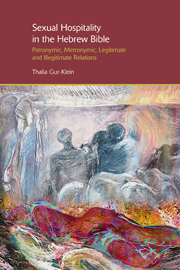 Sexual Hospitality in the Hebrew Bible
Sexual Hospitality in the Hebrew Bible Book contents
- Frontmatter
- Contents
- Acknowledgements
- Introduction
- 1 Patriarch hospitality and sexual hospitality
- 2 Marital and non-marital systems
- 3 Baal marriage of dominion
- 4 Metronymic marriage: remaining with kin – counter-patterns of baal marriage
- 5 Intersecting patterns and conflicting imperatives
- 6 Widow marriage, land and kin surrogacy
- Epilogue: moral imagination
- Notes
- Bibliography
- Index
6 - Widow marriage, land and kin surrogacy
- Frontmatter
- Contents
- Acknowledgements
- Introduction
- 1 Patriarch hospitality and sexual hospitality
- 2 Marital and non-marital systems
- 3 Baal marriage of dominion
- 4 Metronymic marriage: remaining with kin – counter-patterns of baal marriage
- 5 Intersecting patterns and conflicting imperatives
- 6 Widow marriage, land and kin surrogacy
- Epilogue: moral imagination
- Notes
- Bibliography
- Index
Summary
Approaching the story of Ruth, I aspire to put forward the perspectives of its contemporary spirit, characters and circumstances, hoping to avoid propensities of a woman of my time. Superimposing contemporary values on ancient societies without understanding their perspectives would create the impression that ancient societies were less intelligent because they did not drive cars or were less aware of cruelty, atrocities or moral and societal issues than our society, using swords instead of smart bombs. Our ancestors seem morally deeply in touch with the physical reality of hunger and blood spilling. We have turned widows into cases of registration, and a victim into a moving shadow or a picture on a screen: a representation that supplants the real subject of killing, separating the experience of atrocity from its moral consequences; making the distance between the victim and the victimizer unbridgeable.
In the following, I shall be looking into the story of Ruth from its contemporary perspectives of kin relations, widow's marriage and land. The Book of Ruth revolves around two widows deprived of natal kinsmen, offspring and land. Stretched over a mere four chapters, the story opens with a spell of famine in Bethlehem and a natal household forced to leave for a foreign country, Moab: ‘Now it came to pass in the days when the judges ruled, that there was a famine in the land.
- Type
- Chapter
- Information
- Sexual Hospitality in the Hebrew BiblePatronymic, Metronymic, Legitimate and Illegitimate Relations, pp. 271 - 303Publisher: Acumen PublishingPrint publication year: 2013


